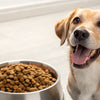Is Wet Food Better Than Kibble for Dogs? A Comprehensive Guide
- Houndsy
Table of Contents
- Introduction
- Understanding the Basics: How Wet and Dry Food Is Processed
- The Benefits of Wet Food
- The Drawbacks of Wet Food
- The Benefits of Dry Food
- The Drawbacks of Dry Food
- Mixing Wet and Dry Food: The Best of Both Worlds
- Recommendations Based on Life Stage and Health Needs
- Conclusion
Introduction
As dog lovers, we often find ourselves pondering the best ways to nourish our furry friends. With countless options available, one of the most debated topics is whether wet food is better than kibble for dogs. Did you know that approximately 60% of dog owners feed their pets dry food exclusively, while only 30% opt for wet food? This statistic underscores the need to explore the benefits and drawbacks of both food types to make informed feeding decisions.
Choosing the right food for our dogs is not merely a matter of preference; it can significantly impact their health and well-being. In this blog post, we will delve into the differences between wet and dry dog food, examining their nutritional profiles, palatability, convenience, and specific health benefits. By the end, we aim to equip you with the knowledge to make the best dietary choices for your canine companion.
We will cover the following aspects:
- The processing methods for wet and dry dog food
- Key nutritional differences and health implications
- Advantages and disadvantages of each food type
- The potential for mixing wet and dry food
- Recommendations for different types of dogs and their specific needs
So, as we embark on this journey to understand if wet food is better than kibble for dogs, we invite you to reflect on your own pet's feeding routine. Are they thriving? Are there changes you can make to enhance their dining experience? Let’s get started!
Understanding the Basics: How Wet and Dry Food Is Processed
Wet Dog Food Processing
Wet dog food, often referred to as canned food, undergoes a unique processing method. The primary ingredients, usually high-quality proteins, are first ground and mixed with a blend of nutrients, including vitamins and minerals. This mixture is then cooked and sterilized, leading to a final product that boasts a moisture content of up to 78%. This high moisture level makes wet food an excellent choice for dogs that may not drink enough water, enhancing their hydration.
Dry Dog Food Processing
In contrast, dry dog food, commonly known as kibble, is produced through a different method. The protein sources are pulverized into a dough-like consistency, which is then cooked and extruded into specific shapes. Afterward, the kibble is dried, with moisture content typically around 10%. This process creates a shelf-stable product that is convenient for storage and feeding.
Comparing Nutritional Profiles
Both types of dog food can provide balanced nutrition, but they differ significantly in their composition. Wet food generally contains higher protein and fat content, while dry food tends to be lower in fat but higher in carbohydrates. These differences can influence your dog’s overall health, weight, and energy levels.
The Benefits of Wet Food
Enhanced Hydration
One of the most significant advantages of wet food is its high moisture content, which aids in keeping dogs hydrated. This is particularly beneficial for dogs with urinary or kidney issues, as adequate hydration can help prevent complications. If your dog is reluctant to drink water, incorporating wet food into their diet can be a simple yet effective solution.
Palatability and Appetite Stimulation
Wet food is often more aromatic and flavorful than kibble, making it an appealing choice for picky eaters or dogs with decreased appetites due to illness or age. The palatability of wet food can entice dogs to eat, ensuring they receive the necessary nutrition they need, especially during recovery from surgery or illness.
Increased Satiety
Wet food may promote a feeling of fullness more effectively than dry food. This can be advantageous for weight management, particularly for dogs that seem to have an insatiable appetite. The higher moisture content reduces calorie density, allowing dogs to enjoy a more substantial portion without overeating.
Easy to Chew
For dogs with dental issues or those that are older, wet food can be easier to chew than dry kibble. This can improve their overall dining experience and ensure they receive essential nutrients without straining their teeth or gums.
The Drawbacks of Wet Food
Cost Considerations
Despite its benefits, wet food tends to be more expensive per calorie than dry food. This can become a significant factor for pet owners, especially those with larger breeds or multiple dogs. The cost of feeding exclusively wet food may not be feasible for every household.
Spoilage and Waste
Wet food has a shorter shelf life once opened and can spoil quickly if not consumed promptly. Leftover portions must be refrigerated and discarded after a few days, leading to increased food waste. This can be a concern for dogs that prefer to graze or take their time with meals.
Dental Health Concerns
Unlike dry food, which can promote dental health by encouraging chewing, wet food does not provide the same benefits. Dogs that primarily consume wet food may experience more tartar buildup, necessitating a rigorous dental hygiene routine.
The Benefits of Dry Food
Convenience and Portability
Dry food is incredibly convenient for pet owners. It has a long shelf life, is easy to store, and can be measured out for precise portions. Kibble is perfect for those who have busy schedules or prefer to pre-portion meals.
Dental Health Benefits
One of the most significant advantages of dry kibble is its potential to promote dental health. The chewing action required to break down kibble can help reduce tartar and plaque buildup, leading to healthier teeth and gums.
Cost-Effective
Generally, dry food is more cost-effective than wet food, making it a popular choice for long-term feeding. The lower price point allows owners to provide quality nutrition without overspending.
Versatile Feeding Options
Dry food can be easily incorporated into interactive feeding toys and puzzles, providing mental stimulation for dogs. This enrichment can improve a dog’s quality of life and encourage healthy eating habits.
The Drawbacks of Dry Food
Low Moisture Content
The primary drawback of dry food is its low moisture content. For dogs that do not drink enough water, this can lead to dehydration and urinary issues. If your dog falls into this category, it is essential to monitor their water intake and consider supplementing with wet food.
Less Palatable
While many dogs enjoy kibble, others may find it less appealing than wet food. If your dog is a picky eater, you may need to explore various brands and formulations to find one that satisfies their taste buds.
Mixing Wet and Dry Food: The Best of Both Worlds
For many pet owners, a combination of wet and dry food provides the ideal solution. Mixing the two can offer the palatability and hydration benefits of wet food while retaining the dental and convenience advantages of dry kibble. Here are some tips for effectively mixing the two:
- Consult Your Veterinarian: It’s always best to consult with a veterinarian when altering your dog’s diet. They can provide guidance on caloric needs and the appropriate ratio of wet to dry food.
- Monitor Portions: Carefully measure the total daily intake to avoid overfeeding. Be mindful of the calories you’re offering from both food types and adjust accordingly.
- Observe Your Dog's Preferences: Pay attention to how your dog responds to the mixed diet. Some dogs may prefer more wet food, while others may enjoy a larger proportion of kibble.
Recommendations Based on Life Stage and Health Needs
Puppies
Puppies require a diet rich in protein and fat to support their growth and development. Both wet and dry puppy foods are available, and owners should consider their dog's specific needs. Mixing wet and dry food can also help ease the transition to solid food.
Adult Dogs
For adult dogs, the best diet will depend on their activity level, breed, and health. Active dogs may benefit from higher protein dry food, while those prone to urinary issues might thrive on wet food.
Senior Dogs
Senior dogs often experience dental issues, making wet food a suitable option for easier consumption. However, maintaining dental hygiene remains crucial, so consider incorporating dental treats or dry kibble into their routine.
Dogs with Special Health Needs
Dogs with specific health conditions, such as kidney disease or obesity, may require specialized diets. In these cases, consulting your veterinarian is essential to determine the most appropriate food type.
Conclusion
In the ongoing debate of whether wet food is better than kibble for dogs, the answer is not straightforward. Each type of food comes with its unique advantages and disadvantages, and the best choice often depends on your dog's individual needs, preferences, and health considerations.
By understanding the differences between wet and dry dog food, we can make informed decisions that enhance our pets’ overall well-being. If you're considering elevating your dog's feeding experience, we invite you to explore the Houndsy Kibble Dispenser. Designed for convenience and portion control, it complements both wet and dry feeding routines while adding a touch of modern elegance to your home.
Frequently Asked Questions
1. Can I mix wet and dry dog food together?
Yes, many pet owners mix wet and dry food to provide a balanced diet that combines the benefits of both types. Just ensure you're monitoring portion sizes and caloric intake.
2. Is wet food more nutritious than dry food?
Both wet and dry dog foods can be nutritionally balanced, but wet food typically contains higher protein and moisture content, which can be beneficial for hydration.
3. How do I know which food is best for my dog?
Consulting with your veterinarian is the best way to determine the most appropriate diet for your dog, taking into account their age, activity level, and health status.
4. What are the dental health implications of wet food?
Wet food does not provide the same dental benefits as dry kibble, which can help reduce tartar buildup. Regular dental care is important for dogs that primarily consume wet food.
5. Are there any health risks associated with feeding wet food?
While wet food can be a great option for many dogs, it is generally more expensive, can spoil quickly, and does not promote dental health as effectively as dry food.
By understanding these nuances, we can provide our dogs with the best care possible while simplifying our feeding routines. Remember, whether you choose wet, dry, or a combination of both, the goal is to keep our furry companions happy and healthy!












